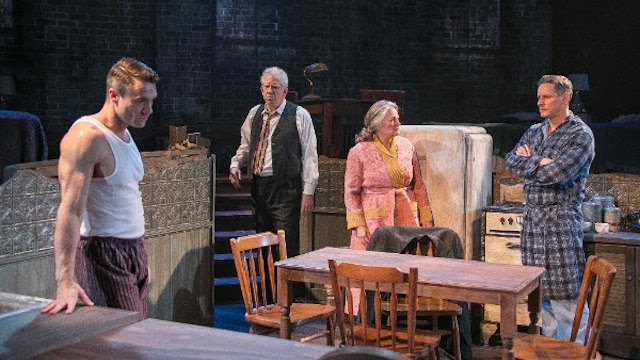This November, Bay Street Theater is putting on its ninth production for Literature Live! with famed playwright Arthur Miller’s Death of a Salesman. The English class-meets-theater program extends curriculum beyond the classroom by highlighting classic novels that are commonly studied by middle school and high school students. In imbuing the words of the author with life and allowing students to talk about the content through post-show panel discussions, Literature Live! provides a unique opportunity for students to explore literature beyond the book.
With the adaptation of the story from “page to stage,” students have the opportunity to understand the protagonist more deeply by watching how he gestures and behaves; they can glean a better understanding of the context in which the story takes place with the visual aid of props, the setting, and costume of the characters; ultimately, they are afforded a chance to experience a story through a different medium: live theater, an art form to which some students lack access. The program was developed to remedy this void that had been left by cuts to performing arts programs. “We were trying to give access to students who might not have access to live theater, that is how it started,” Tracy Mitchell, Executive Director of the Bay Street Theater, told Hamptons.com.
Initially, students and teachers were charged admission to attend a show. It did not take long, though, for Mitchell and others to realize that the fee was precluding many schools from attending. Mitchell recounted getting phone calls from educators, in which they asked if the theater could pay for their transportation or provide some financial assistance (which it could not). This demand for assistance, though, eventually prompted a solution. With the financial backing of the Board of Trustees and the Century Arts Foundation, the theater was able to make the Literature Live! program free for all school groups – a policy that continues to this day.
 |
|
Literature Live! provides a unique opportunity for students to explore literature beyond the book. (Willy Loman) and (Photo: Lenny Stucker) |
“We need children and young adults to see live theater and we were very committed to that. Sort of no matter what it takes because in the end we feel that it’s that important,” said Mitchell. The decision had a measurable impact: in the first year of the program (when there was an admission fee), around 500 students attended; now, the theater sees over 3,000 students a year, with over 56 schools having been served in total. The theater has seen school groups from as far west as Port Washington and as far east as Montauk, and has about 12 different districts visiting for this year’s production. Just this week, the theater received school groups from Shoreham, Sag Harbor, Bellport, and all of Pierson high school.
The process for bringing the novel to stage begins about a year in advance. Art teachers, English teachers, and curriculum specialists are all consulted to help determine which novel will be selected for a theatrical rendering that year. In selecting the production, they must consider how many grades read the book, and whether or not the book is a significant focus for that school year. “We try to get as broad a range as possible so to provide the best access we can to as many age groups as we can,” Mitchell explained.
Since the beginning, Literature Live! has also included question and answer sessions at the end of each show – providing yet another way for the students to engage with the themes, characters, and ideas of the novel. For some productions, the panel is comprised of the actors and actresses. Other times, though, the speaker may be a person relevant to the subject matter, which was the case for the production of The Diary of Anne Frank. Students had the opportunity to speak with a Holocaust survivor, something that Mitchell said made the viewing very personal and brought the content of the book into “sharp focus.”
Question and answer discussions also allow students to hear the thoughts and opinions of students from other schools, who may come from different backgrounds. “There have been really interesting conversations between different schools, because we’ll have three to four schools coming from vastly different socioeconomic backgrounds, different races, etcetera, it is really fascinating to hear the varying opinions on what they have just seen and how they react to it,” Mitchell noted.
 |
|
Performances are also open to the public. (Photo: Lenny Stucker) |
After the first viewing of Death of a Salesman, students considered the “American Dream” – a major theme of the play. “I was wondering if students would connect with that, and they connected to it in a huge way, they were completely engaged, and that was really great to see,” recalled Mitchell.
The theater currently has a 2017 Literature Live Challenge Grant, in which the Board of Trustees and the Century Arts Foundation have offered to match, dollar-for-dollar, every donation up to $100,000. The donations support every piece of these professional productions – from the props to the costume designers – and will allow the Free Student Ticket Initiative to continue.
And while this program is a huge advantage for educators and students, the schools aren’t the only ones who benefit. The performances, which feature professional actors, are also open to the public.
Death of a Salesman first opened to students on Monday, November 6 and will run through November 25. Tickets range between $20 and $55 for those that do not belong to a school group.
Bay Street Theater is a not-for-profit organization founded in 1991. It is located at 1 Bay Street in Sag Harbor. To purchase tickets or donate, please call 631-725-9500 or visit www.baystreet.org.












